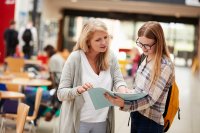Making Advisory More Effective
A simple plan for advisory includes self-reflection to help students see their growth over time.
Your content has been saved!
Go to My Saved Content.Schools across the country have added advisory time to the master schedule in the hope that the 20 to 30 minutes allocated during the day will develop stronger teacher-student relationships and improve student achievement. Having an adult who is charged with looking after the grades and social and emotional needs of a small group of students offers many possibilities for student-led growth.
When I served as a superintendent, all of my secondary schools had a scheduled advisory time. Some schools used it for study hall, and others used it for announcements or character development. Occasionally, they would use the time to discuss grades or hand out report cards. I noticed that many teachers and students gave up on the potential of advisory time because they didn’t see the value, saw it as a waste of time, or didn’t have the tools to make it more effective.
When I became a turnaround leader at Carpe Diem Innovative Charter Schools in San Antonio, I sought to create an advisory system that worked. We focused on student-led goal setting, self-tracking, and consistent reflection on strategies and progress. The results were impressive, and the protocol is easy to try in different contexts.
A Simple, Proactive, Student-Led System
In our advisory design, every adult in the building had an advisory group that met daily. Our goal-setting and reflective learning work took place on a weekly cycle. Every Friday, students took the following steps:
1. Tracked their current grades: Students checked their real-time grades in our grading system, and individually logged them for each class. They were able to see what they had accomplished in lessons and assignments from the past week. Prior to this protocol, students had access to their online grades—but very few looked at them regularly, and even fewer thought strategically about how to improve.
2. Reflected on strategies and set goals: Students wrote a brief reflection on what strategies had worked for them the previous week and what actions they were going to take in the next week to improve. We used a specific self-direction rubric to guide students on their reflections, and we added example learning strategies over the course of the year.
3. Received feedback from their advisor: We built in time for each student to have a short one-on-one check-in with their advisor each Friday. We reviewed student goals, asked prompting questions, and gave suggestions on next steps. Our system allowed teachers to provide feedback virtually, if needed.
The student reflection portion of the protocol was done in an online platform, but it could be done on paper as well. It took approximately 15 to 20 minutes each week.
Empowering Students Yields Results
Over time, I noticed my advisees beginning to associate certain strategies with success. The associations moved from “I just tried harder” to “I used a new vocabulary review strategy” or “I checked my tracker every day and set a daily goal for completing lessons in Spanish.”
Monthly, teachers brought in samples of student reflections so we could enhance their effectiveness. We used weekly coaching with students to help them think deeply about their strategy use and reflections. Students also saw graphs and visual trends over time, which made it easier to connect specific strategies with growth.
Through surveys, we found that students’ sense of self-direction improved, as did their feelings that adults in the building understood and cared for them. Our high school students increased the number of end-of-course assessments passed from the previous year by 20 percent and earned 53 percent more credits. Much of this success can be attributed to students tracking their learning and reflecting on their learning strategies. We also saw higher GPAs in students who completed weekly cycles of self-tracking and reflection than their peers who did not participate.
Coupling this time-effective routine with individual meetings with a caring adult and intervention systems makes a significant difference in advisory time effectiveness and overall student success. Developing noncognitive skills through a simple protocol and responsive platform empowers students to take ownership of their grades and learning and see their growth over time.
